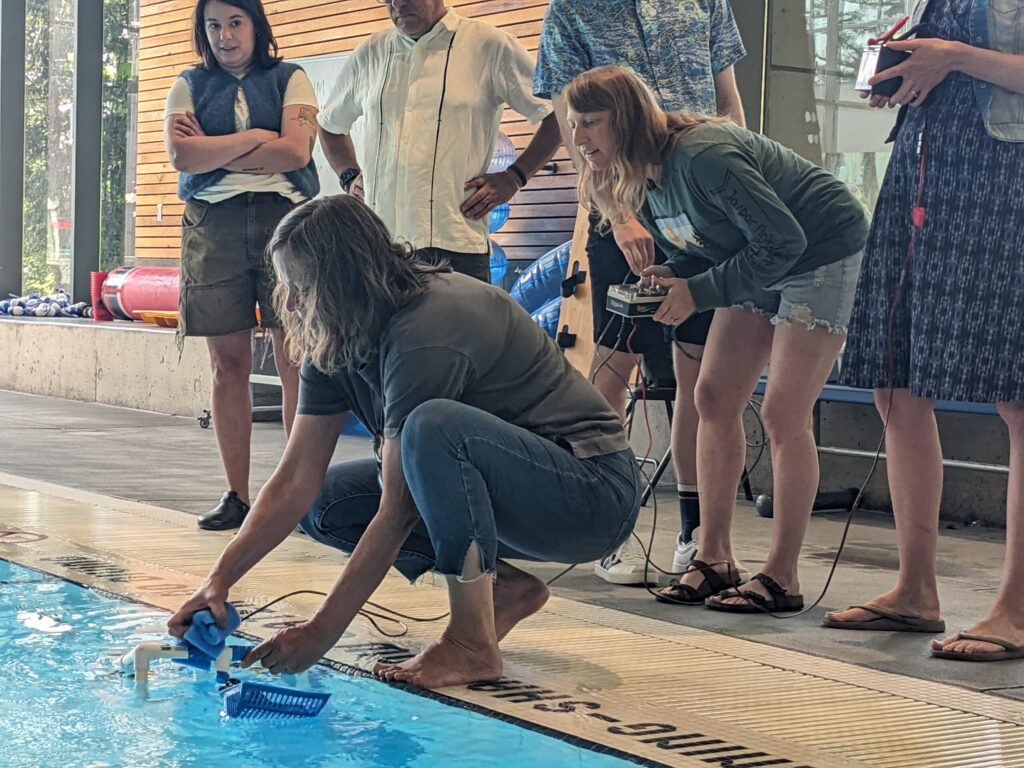Educators testing their Remotely Operated Vehicles (ROVs) was a highlight of the workshop.
It’s one thing to talk about culturally responsive education or seek resources to deepen one’s understanding. But what about attending an immersive five-day training program, turning around and putting what you learned to use with students one week later while being observed by the same people who trained you?
That’s what 14 teachers from Whatcom and Skagit Counties signed up for last month. From August 5 – 9 they attended a Culturally Responsive Elementary Science Teaching (CREST) workshop at Western Washington University (WWU) using the Explore the Salish Sea Curriculum (ESSC) as an avenue to explore the topic.
The workshop was part of a two-year culturally responsive research project through WWU, according to PEI’s Northwest FieldSTEM Coordinator Amy Keiper. “They want to see if teachers have a curriculum over time, as they become more familiar with that curriculum, will you see their culturally responsive teaching increase?” Keiper explains. “They’re using PEI’s Explore the Salish Sea Curriculum because it already includes a lot of opportunities to integrate Coast Salish knowledge.”
“The process of science and good teaching is to explore, make mistakes with your students, decide what does and doesn’t work, and then implement what you’ve learned the next time. There was a real feeling of camaraderie and ease.” — Amy Keiper, PEI’s Northwest FieldSTEM Coordinator
Earlier in the spring, teachers attended an asynchronous course on culturally responsive learning before diving into the ESSC curriculum during the August workshop. Keiper and PEI’s Multicultural Program Coordinator Lourdes Flores co-facilitated the five-day event with Dr. Jesus Perez-Linares, a 5th-grade teacher at West View Dual Language School in Burlington under the direction of ESSC author Mira Lutz and WWU Professor of Science Math and Technology Education (SMATE) Debi Hanuscin.

Flores and Perez-Linares shared strategies for culturally responsive teaching during the first week and spent the second helping educators adapt their curriculum in culturally responsive ways with students attending a summer camp program at WWU.
“Every day we would solicit reflections from the teachers, and we would use those to plan our next session,” Flores says. “In culturally responsive learning, you use everything you learn from your students to plan your next approach.”
While it may seem daunting to put a freshly learned concept into practice under scrutiny, the process was collaborative and supportive, says Keiper. “Debi Hanuscin made it clear that the process of science and good teaching is to explore, make mistakes with your students, decide what does and doesn’t work, and then implement what you’ve learned the next time. There was a real feeling of camaraderie and ease.”
Over the next two school years, researchers will continue to collect data as teachers implement culturally responsive learning in their classrooms. An additional cohort will complete the same training in the spring.
Flores notes that the team facilitating the workshop effectively modeled both culturally responsive teaching practice and scientific study. “It was a great experience,” she says. “We learned how we would integrate things differently next time and had a lot of feedback for each other. The team worked together really well.”
